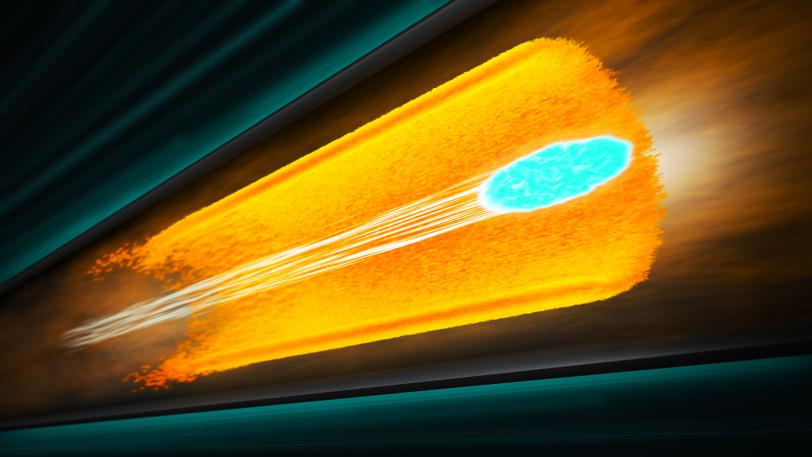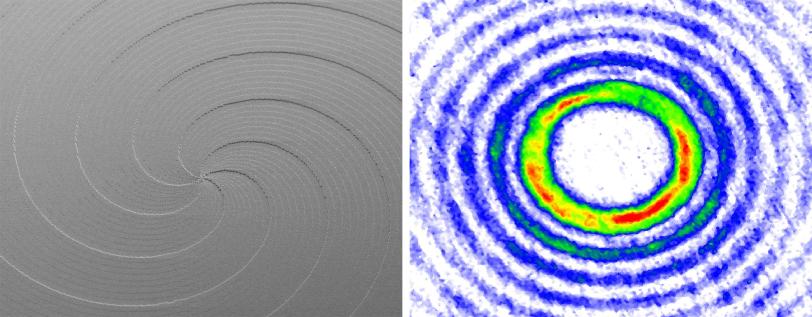A Plasma Tube to Bring Particles up to Speed at SLAC
Boosting Particle Energies Inside Hollow Channels of Ionized Gas Could Be a Crucial Step Toward Better, More Compact Particle Accelerators
A team led by scientists from the University of California, Los Angeles and the Department of Energy’s SLAC National Accelerator Laboratory has reached another milestone in developing a promising technology for accelerating particles to high energies in short distances: They created a tiny tube of hot, ionized gas, or plasma, in which the particles remain tightly focused as they fly through it.
The technique is especially important for positrons, the antimatter siblings of electrons, which tend to lose focus as they travel through plasma during a process known as plasma wakefield acceleration. In tests at SLAC’s Facility for Advanced Accelerator Experimental Tests (FACET), a DOE Office of Science User Facility, beams of positrons stayed tightly bundled as they traveled through the plasma tube.
“Being able to efficiently create particle beams that are both highly energetic and focused is a prerequisite for many state-of-the-art accelerator applications,” says SLAC’s Marc Hogan, co-principal investigator of a study published today in Nature Communications. “Our results bring us a step closer to making plasma-driven particle accelerators a reality.”
Such devices could potentially power future particle colliders that reveal nature’s fundamental components, as well as bright X-ray light sources that take ultrafast snapshots of materials with atomic resolution.
A Plasma Tube to Keep Speedy Particles on Track
In plasma wakefield acceleration, energetic bundles of electrons or positrons traverse a plasma and generate plasma “wakes” for trailing bunches of particles to ride. Since the method can boost the energy of the surfing particles up to 1,000 times more over a given distance than conventional technology, it could pave the way for next-generation accelerators that are more powerful, smaller and less expensive.
However, the technique has yet to overcome a major challenge: Strong forces pointing toward the center of the plasma can degrade the quality of the particle beam, which consists of bunches of electrons or positrons. In the positron case, the particles are defocused and lost in the plasma.
Now, says SLAC’s Spencer Gessner, the lead author of the new study, “We’ve engineered a hollow plasma channel – a tube of plasma with neutral gas on the inside. Due to the particular geometry of the plasma, particles flying through the channel don’t experience any of the unwanted forces.”

Proof-of-Principle Experiment at FACET
The idea of creating plasma tubes has been around for about 20 years, but Gessner and his fellow researchers are the first to demonstrate that they can actually make these channels large enough for particle acceleration experiments.
To create plasma for their experiments, the researchers send a high-power laser through a hot gas of the chemical element lithium. Normally, the laser beam’s intensity is rather uniform and therefore generates a uniform plasma.
But in this case, they first sent the beam through a special spiral-shaped grating, which shaped the laser beam in such a way that if you looked at it in cross-section, it would consist of concentric rings. The innermost ring was the only one intense enough to create plasma, and as the laser beam traveled through a cloud of lithium gas, this ring formed a plasma tube about 3 inches long and two-hundredths of an inch wide. The tube persisted for just a few trillionths of a second – long enough for the scientists to send one of FACET’s powerful positron beams through it.
“Our results indeed show that the positron bunch doesn’t get defocused as it travels through the tube,” Gessner says. “But we found even more: The plasma responds by producing a wake that takes a lot of energy out of the bunch. This energy could be used to accelerate a trailing bunch of positrons.”

Next Steps Toward Future Applications
The team will soon follow up with experiments aimed at demonstrating that the technique can in fact boost the energy of positrons that surf the plasma wave inside the hollow channel. The researchers also intend to improve the method’s efficiency by increasing the amount of energy stored in the wake, which already corresponds to 10 times the acceleration power of conventional radiofrequency acceleration technology.
“With its unique combination of powerful positron beams and high-power lasers, FACET is the only place in the world where we can do this type of research,” Hogan says. “We’re looking forward to further exploring this exciting approach to plasma wakefield acceleration.”
In addition to UCLA and SLAC, the following institutions contributed to this work: University of Oslo, Norway; University of Paris-Saclay, France; and Tsinghua University, China. The project received funding from the DOE, the Research Council of Norway, the National Science Foundation, the European Research Council and the National Basic Research Program of China.
Citation: S. Gessner et al., Nature Communications, 2 June 2016 (10.1038/ncomms11785).
For questions or comments, contact the SLAC Office of Communications at communications@slac.stanford.edu.
SLAC is a multi-program laboratory exploring frontier questions in photon science, astrophysics, particle physics and accelerator research. Located in Menlo Park, Calif., SLAC is operated by Stanford University for the U.S. Department of Energy's Office of Science.
SLAC National Accelerator Laboratory is supported by the Office of Science of the U.S. Department of Energy. The Office of Science is the single largest supporter of basic research in the physical sciences in the United States, and is working to address some of the most pressing challenges of our time. For more information, please visit science.energy.gov.





